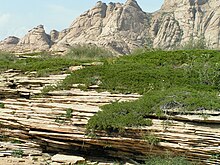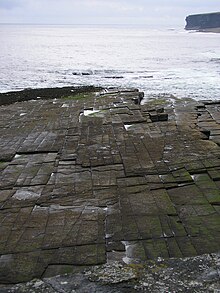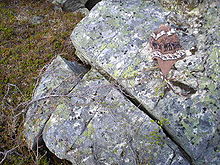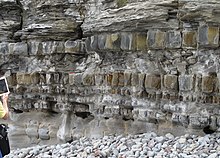








A joint is a break (fracture) of natural origin in a layer or body of rock that lacks visible or measurable movement parallel to the surface (plane) of the fracture ("Mode 1" Fracture). Although joints can occur singly, they most frequently appear as joint sets and systems. A joint set is a family of parallel, evenly spaced joints that can be identified through mapping and analysis of their orientations, spacing, and physical properties. A joint system consists of two or more intersecting joint sets.[1][2][3]
The distinction between joints and faults hinges on the terms visible or measurable, a difference that depends on the scale of observation. Faults differ from joints in that they exhibit visible or measurable lateral movement between the opposite surfaces of the fracture ("Mode 2" and "Mode 3" Fractures). Thus a joint may be created by either strict movement of a rock layer or body perpendicular to the fracture or by varying degrees of lateral displacement parallel to the surface (plane) of the fracture that remains "invisible" at the scale of observation.[1][2][3]
Joints are among the most universal geologic structures, found in almost every exposure of rock. They vary greatly in appearance, dimensions, and arrangement, and occur in quite different tectonic environments. Often, the specific origin of the stresses that created certain joints and associated joint sets can be quite ambiguous, unclear, and sometimes controversial. The most prominent joints occur in the most well-consolidated, lithified, and highly competent rocks, such as sandstone, limestone, quartzite, and granite. Joints may be open fractures or filled by various materials. Joints infilled by precipitated minerals are called veins and joints filled by solidified magma are called dikes.[1][2]
- ^ a b c Mandl, G. (2005) Rock Joints: The Mechanical Genesis. Springer-Verlag, Heidelberg, Germany. 221 pp. ISBN 978-3-540-24553-7
- ^ a b c Davis, G.H., S.J. Reynolds, and C. Kluth (2012) Structural Geology of Rocks and Regions (3rd ed.): John Wiley and Sons, Inc., New york, New York. 864 pp. ISBN 978-0471152316
- ^ a b Goudie, A.S. (2004) Encyclopedia of Geomorphology volume 2 J–Z. Routledge New York, New York. 578 pp. ISBN 9780415327381